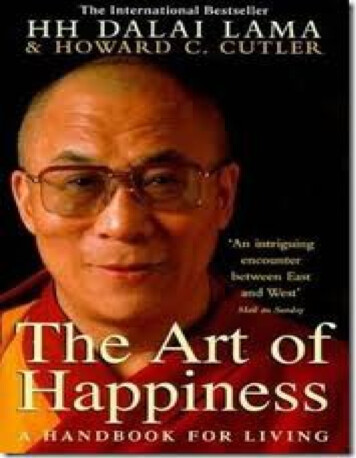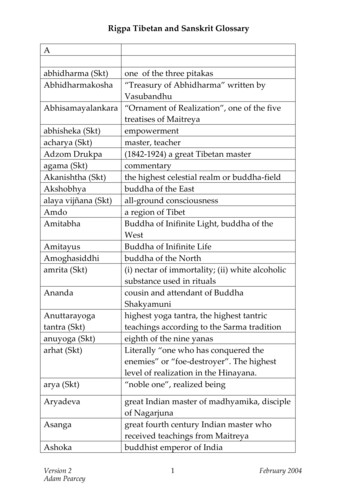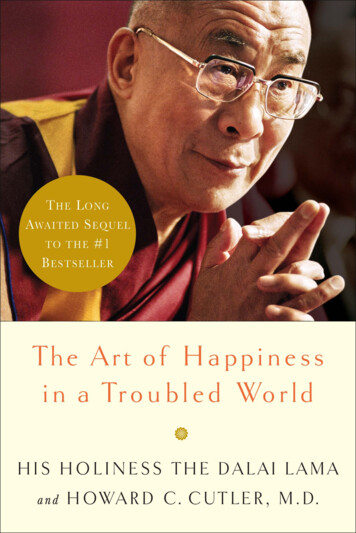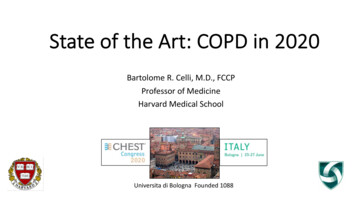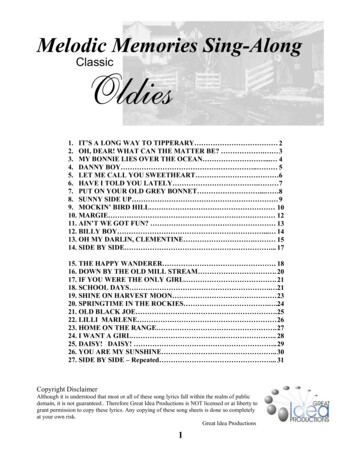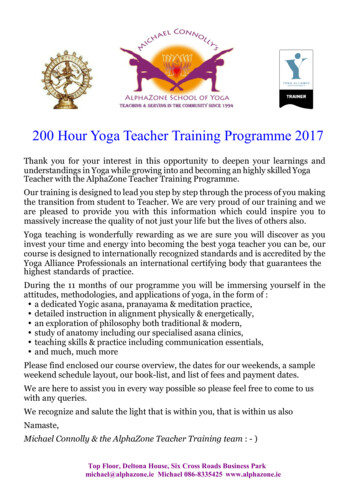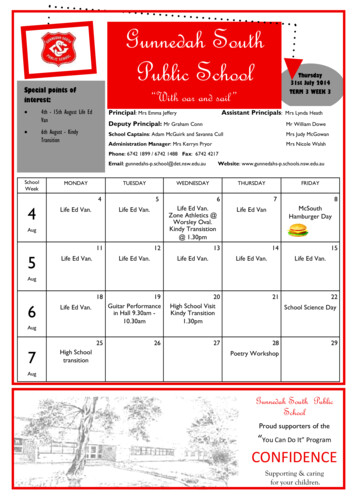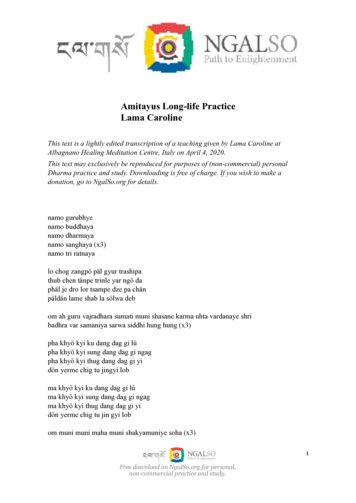
Transcription
!Amitayus Long-life PracticeLama CarolineThis text is a lightly edited transcription of a teaching given by Lama Caroline atAlbagnano Healing Meditation Centre, Italy on April 4, 2020.This text may exclusively be reproduced for purposes of (non-commercial) personalDharma practice and study. Downloading is free of charge. If you wish to make adonation, go to NgalSo.org for details.namo gurubhyenamo buddhayanamo dharmayanamo sanghaya (x3)namo tri ratnayalo chog zangpö päl gyur trashipathub chen tänpe trinle yar ngö daphäl je dro lor tsampe dze pa chänpäldän lame shab la sölwa debom ah guru vajradhara sumati muni shasane karma uhta vardanaye shribadhra var samaniya sarwa siddhi hung hung (x3)pha khyö kyi ku dang dag gi lüpha khyö kyi sung dang dag gi ngagpha khyö kyi thug dang dag gi yidön yerme chig tu jingyi lobma khyö kyi ku dang dag gi lüma khyö kyi sung dang dag gi ngagma khyö kyi thug dang dag gi yidön yerme chig tu jin gyi lobom muni muni maha muni shakyamuniye soha (x3)!1Free download on NgalSo.org for personal,non-commercial practice and study.
om maitreya maitreya maha maitreya arya maitreya soha (x3)om ah hum karuna karuna maha karuna arya karunaye soha (x3)Hello everybody. Welcome to the Albagnano 2020 Easter course. Every year here inAlbagnano we've had an Easter course – usually with many friends coming from all overthe world, but this time we're meeting together virtually. To the best of our ability we aretrying to continue with our normal programme as much as we can. Because that's the bestthing to do. I'm sat here in my office and Carmen, who's doing the streaming, is in thegompa because we're also doing the mantra marathon of long-life mantras. We're tryingour best to follow the advice of the Italian government of social distancing. That’s whywe're doing like this. So thank you all for tuning into NgalSo free TV.Today we're going to talk about the third long-life practice that Lama Gangchen suggeststhat we do – Guru Buddha Amitayus. Today I’d like to explain to you how to do thispractice for those of you who would like to join in the enlightenment marathon – which Ihope you will - then you can do it in the best way, get the most benefit for yourself and forothers. That's why we're explaining the practices these days. Before I start: these days, Iexplained the Parnashawari practice and now I’m explaining the 3 long-life buddhas:Ushnishavijaya, White Tara, and Amitayus.Tomorrow on Easter Sunday, I will talk a little bit about karma and astrology and I'd liketo do a guided meditation on the five different principal meditations of Parnashawari sothat we can dedicate, collectively, our energy to all those who are sick, who are sufferingbecause of the pandemic that we're all experiencing now. So tomorrow we’ll do like that.Then in two days time, on Tuesday, we're going to do the explanation of Black Manjushri– how to recite the mantras and how to the visualisations. These are all the core essentialpractices that Lama Gangchen recommended we do during this time during the pandemic.After this, I will have explained a lot of practices, a lot of different things, so I wasthinking: honestly, it's better we all settle down and try and practice. Not just all the timereceive more and more instructions and not use them. So from next week onwards, whatI'd like to do is: every few days to continue to meet with you all, whoever wants to, onlive-stream. I will start to read some of Lama Gangchen’s books; for example, we couldstart with Peace Words, words of peace. Because I think it's very nice, it’s Rinpoche’sactual ideas about peace. You can download Peace Words from the ngalso.org site, in thetranscript section. It's freely available if you want it. I'll start to read it like an audiobook.Recently, I've been listening to a lot of audiobooks during this lockdown. It would be verynice to do some audiobook reading of Lama Gangchen’s books. I'll read some of LamaGangchen’s books and then maybe give some of my own thoughts and opinions aboutwhat I have heard on the subject. We can do these kind of things. Who knows how longwe've got? Nobody knows, so we'll see how long we go on for. Then I might start to readLama Gangchen’s medicine book A Rainbow of Healing Nectars. I'm just telling you mythoughts about what we could do in the week(s) ahead: mainly to practice together andthen every afternoon, I will read you some Dharma teachings, some of Rinpoche’steachings and give some short explanations and thoughts. And we will continue like that.Regarding the lockdown, I think honestly it’s best we just stop worrying about when it willfinish because this is causing anxiety, it's causing stress. Maybe we’ll just try, like they say!2Free download on NgalSo.org for personal,non-commercial practice and study.
in Buddhism to be here now and settle into this experience, try to make the best of it,spend this time like a retreat, spend our time doing dharma practice, meditating, sendingpositive energy to others who are in need. This is the best thing to do at the moment. Sothank you – that was just my thoughts on what I'd like to share with you.So, Guru Buddha Amitayus. In Indo-Tibetan Buddhism we have a trinity of long-lifebuddhas, who are Ushnishavijaya, White Tara and Guru Buddha Amitayus. Again, most ofyou have received the initiation many times, but in case there's anybody who has not, Iwill give an emergency transmission of the mantras so that at least you can recite themantra and participate in the enlightenment marathon – the marathon of doing long-lifemantras for the benefit of our mother, our father, our Guru, our family, our friends, oursangha, our town, our country, the world; for the elements, for the environment, for allthose who are sick and suffering, so many different ways in this moment. So we'll do likethis.I'm going to read you a little bit of the Amitayus sadhana that's available from LamaGangchen Peace Publications. If you want a copy, please contact the virtual shop of PeacePublications and maybe they can send you one electronically. We have a PayPal system Ithink.NgalSo Tantric Self-Healing Practice of Buddha Amitayus – Method to increase lifespanwisdom and method, by Lama Gangchen Rinpoche, edited by Lama Caroline. Firstedition, September 2015.The healing techniques used in this practice are not intended to replace treatment from aqualified medical practitioner. They can however be used to aid both physical and mentalhealing.Dedication by Lama Gangchen Rinpoche:May the lifespan, wisdom and merit of anybody who completes the mantra recitation andpractice of Guru Buddha Amitabha increase. May tasting the nectar of long life heal allthe causes of samsaric body, speech and mind. May Buddha Amitayus, the coral-red deityof long life help us to overcome the suffering and fear of ordinary life and the fear of deathand to achieve the siddhi the realisation, of immortality. May all living beings enjoy innerand world peace now and forever, by the attention of all human beings and by the blessingof all the holy beings.So that's the dedication by Lama Gangchen Rinpoche.IntroductionAmitayus is a Sanskrit name. Ayus means life in Sanskrit and amrita means deathless,immortal, so Amitayus literally means immortal life.Amitayus is a long life emanation of Supreme Healer Amitabha.!3Free download on NgalSo.org for personal,non-commercial practice and study.
As you all know, in our NgalSo Buddhism, we have a very big interest in the FiveSupreme Healer Buddhas: Vairochana, Amitabha, Akshobya, Ratnasambhava andAmoghasiddhi. Amitabha is the Buddha who is particularly related to the throat chakraand who is about transforming our emotions and our unlimited desire. This transformationis into what we call discriminating wisdom. It’s personified by the red Buddha, SupremeHealer Amitabha, Limitless Light. Amitayus is considered an emanation, a manifestationof Supreme Healer Amitabha. In tantric Buddhism we have “families of buddhas”. Wehave hundreds of different meditation practices but they are grouped into these fivefamilies, so they have a predominant energy. So all the buddhas of the Amitabha family –for example, Chenrezig and Amitayus have a similar kind of vibration actually: of love,empathy and compassion, one special vibration.Back to the introduction:The particular qualities of Amitayus are to heal the outer and inner obstacles to our longlife, such as: physical sickness, exhaustion and disease, as well as our fears, our anger,our desire, our ignorance and self-destructiveness. These negative emotions are the maincause for us to be locked within the cycle of birth and death, which we call in Buddhism,samsara.Samsara means again and again the same thing. We're very repetitive, very habitual andgenerally not in a good way.By eliminating these causes through the practice and the blessings of Guru BuddhaAmitayus, we can achieve first health and wellbeing and as a result we have more time todo positive things. And finally we can achieve the siddhi of immortality.In the Tibetan Buddhist tradition, and also in the Indo-Tibetan medical tradition and inAyurveda, we say one of the fruits of medicine is the realisation of long-life. Why shouldwe want a long life? Obviously, we want a long life so that we can do positive things. Inthe Buddhist tradition we want a long-life because we need a lot of time in order to grow,to evolve. We have this special opportunity; we’ve met special conditions for evolution,for spiritual practice. So we'd like to continue with those as as long as possible.Regardless of the fact that we Buddhists believe in reincarnation, we still want this presentlife, this present special condition we have, in which we've met with the completeteachings of the Buddha, where we’ve met special high lamas and gurus; we have so manygood conditions to practise NgalSo and we'd like this to continue for as long as possible.Therefore, we would like good health and long-life. And of course, as Lama Gangchensays in many of his books, whatever we want to do in life – whether we want to be aBuddha, whether we want to be a millionaire, whether we just want to have a happy life –we need good health don't we? We need good health and strong elements. So these kind ofthings we can recover and increase through the practice of Guru Buddha Amitayus.As a fully enlightened Buddha Amitabha also grants us wisdom, compassion, generosityand all the qualities of a bodhisattva.A bodhisattva is somebody who's on the path to awakening, somebody who’s evolving.This practice was transmitted to Tibet by the female Mahasiddha, Drupe Gyälmo, theQueen of Realisations. She gave this precious teaching to Jetsun Milarepa, who was a!4Free download on NgalSo.org for personal,non-commercial practice and study.
very famous Tibetan yogi, and then it was passed to Rechungpa and through the lineage ofTibetan masters and founder of our Gelugpa tradition, Lama Tsongkhapa, in the 14thcentury. He included it in the collection of very important meditations that should be doneby Gelugpa practitioners.Next section: The benefits of the practice of Amitayus according to the Amitayus Sutra.There are actually many Amitayus sutras of this practice. Generally speaking, Amitabhahas always been very popular in Buddhism – there are many Mahayana sutras related toAmitabha and also to Amitayus. Why? Because life is a fundamental concern ofeverybody – everybody would like to have as long a life as possible, a healthy a life aspossible. None of us know how long we've got, but however long our life will be, we wantit to have as much quality as possible. So let me read you the benefits of the practice ofAmitayus according to the Amitabha Sutra:People these days have short lives, living only 100 years, and untimely death often befallsus.Actually around here, in Albagnano, in Verbania, we have some of the longest livingpeople in the world. There was one lady in Intra, she passed away last year, and I think shewas 116 years old and at the time she was the oldest person in the world. But generally inthe Ayurveda they say that one hundred years should be the natural lifespan; but in thepast, people had the potential to live longer.However those who write out or repeat the text called the “Treasury of the virtues andexcellence of the Tathagata Aparamitaya”, or have it written out or just hear the name or,who having obtained a copy of the book keep it in their house and venerate it with flowers,incense, perfume and garlands will be able to live up to 100 years.Also these days you can hear it on YouTube, there are many ways you can hear it on theinternet. So not only should we keep these instructions but also we should strongly putthem into practice.Living beings who hear and remember the 108 syllables of the dharani of this Tathagata,the arhat, the fully awakened Buddha of Unlimited Life and Wisdom, the Excellent ShiningKing, will also lengthen their lifetime. At the time of death they will be reborn inSukhaviti, the Pure Land of Bliss, the Buddha realm of the Tathagata Aparamita; and theywill have endless life dwelling in the world called Immeasurable Accumulation of Virtue.At the time of death 99 kotis [– that's a billion billion –] of Buddhas will appear to themand a thousand Buddhas will stretch out their hands to them. They will wander fromBuddhaland to Buddhaland and they will not experience doubt, ignorance or ambiguousspeech. They will be well received, venerated, being greeted and venerated by all theTathagatas in all the Buddhalands of the ten directions. They will never be born in hell;they will never be born as an animal or in the world of Yama. They will not be causeddeath or injury by the god of death – Mara, or by those gods belonging to the clan ofdeath, by the yakshas, the rakshasas at any inauspicious moment. The four great kingswill protect, defend, guard and follow them. Even animals, birds and ghosts, when theycome to this place where Amitayus is practised, it is entirely inevitable that they shall beawakened to the unexcelled enlightenment.!5Free download on NgalSo.org for personal,non-commercial practice and study.
Those who do the Amitayus practice will become completely free of the five actions ofimmediate retribution. They will never again suffer oppression or, if they are women [ormen as well] – they will never experience sexual violence from men they will never againlive in poverty. Wherever they are born, in each birth they will remember all theirprevious births. They will be able to differentiate and establish as many as 84,000Dharma teachings. They will realise the six perfections and progress on the Bodhisattvapath. Although it may be possible to measure the extent of the merits of giving one of theseven precious substances each to the Tathagatas – Vishpashin, Shikin, Vishvabu,Krakuchanda, Kanakamuni, Kashyapa and Sakyasimba – or the merit of giving precioussubstances equal in extent to the King of Mountains, Mount Meru, and although it may bepossible to count each and every drop of water that fills the great oceans, it is not possibleto measure the merits of the Aparamita Sutra, the practice of Guru Buddha Amitayus.So this is an extract from the Amitayus Sutra. There are several of them. I will uploadthem on our site. If you'd like to download and read them all in depth, they are veryinteresting and inspiring, these ancient Mahayana sutras that talk about the practice ofGuru Buddha Amitayus.Lama Gangchen asked me to explain these practices in a short way, in a condensed way,because now he'd like us to do the mantras. So I won't explain to you all the differentstages of the practice. Actually, there are many different ways to practice Amitayus. Thereare many beautiful meditations to practice Amitayus long-life Buddha. There's a lowertantra way and there's a highest-yoga tantra way with many powerful and beautifulcompletion stage meditations. But because we're doing the long life marathon I'll explainto you one or two long life meditations that everybody can do. Personally, I've receivedthis initiation several times from many high lamas; I’m very lucky. I've also done thisretreat two times so far. I’ll probably end up doing it again but I've done it two times in mylife so I know a little bit about this practice. I also helped to prepare this sadhana withRinpoche some years ago.When we do long-life practices, we're trying to recover our life energy. And there aredifferent ways we can lose our life energy. I've been talking about this over the last coupleof days, the last couple of sessions. I've been saying that when we are born we have acertain amount of life energy that comes with us from our former life (if you believe insuch things). We have a certain large number of breaths. And when we have breathed allthese breaths, our life is finished and we will die; that's the general idea. But actually thelife energy, which is in our heart chakra in what's called the indestructible drop, can berecharged. That's what most people don't know. You can extend your life energy. You canbecome younger, healthier. This is true – I have actually seen people this has happened to.It’s really possible to become younger, more healthy, to recover from sickness by doingthese practices.There are three different ways we can exhaust our life energy. Firstly, they say in theexplanations of the long-life practices that we can exhaust one's life naturally just becausewe are born, then from moment to moment we're ageing, our life is gradually going awayevery day as we breathe in and breathe out. That's why they say we shouldn't get tooexcited: if we start breathing very strongly and start panting our life energy is used up!6Free download on NgalSo.org for personal,non-commercial practice and study.
more quickly. So keep calm and carry on! as they say in Britain. Breathe slower and youwill live longer. Many of the ideas of pranayama are based on this idea that we can extendour breath, our breathing, be calm and live longer. So if we're excitable and stressed andvery anxious and nervous, our life, our energy is going away more quickly. So the firstreason is the natural exhaustion of one's life. The second is we can exhaust our life energydue to our actions. And the third way we can exhaust our life energy is by running out ofpositive energy. So the three basic ideas are: First, we naturally exhaust our life energy byit running out, because it's used up. Second, we can do some positive actions to change ourkarma. Third, we can accumulate punya - merit - to accumulate more positive energy.In the Tibetan Buddhist texts they explain that if one's life is exhausted –through old ageor something, then this can be cured by what's called tsedrub, by long-life rituals. I'veactually seen happen. For example, with one of Rinpoche’s sponsors Tsetan-la inKatmandu, his mother Ama Drolkar-la was apparently supposed to die at a certain age, I'mnot quite sure why. But Rinpoche did these prolonging life rituals for her and now she isaround 90 years old, having lived many more years than was predicted. Every two yearsRinpoche would repeat this ritual and she really is still alive and well. I've seen thatactually several times, this is really possible.If one's karma is exhausted, the Tibetan Buddhist texts explain what is called a ransomritual, where we can exchange the person's life for something else – like paying a ransom.If somebody is kidnapped or or held hostage we can pay a ransom, in this case with aritual and get back the person's life energy. We have these kinds of rituals.If one's punya, one’s positive energy or merit is exhausted, we can increase our punya bygiving offerings. We have many ways to accumulate merit. These are important things toknow. I'm telling you these things now because we're spending a few days talking aboutlong-life practices.If somebody becomes sick, for example, then it's recommended that the person makes adonation to charitable causes, for example, for trees, orphans, religious organisations. togive to charity, OK? There are many people who are in need of help, so you should dosomething for others. One way is you could give some material gift. Another way is tosave the life of others. You might think: Oh I'm not a fireman or a doctor– how am I goingto save the life of others? One thing we can do, for example, is to eat a more plant-baseddiet; that's helpful if you wish to increase your life energy. Let’s say I have one familymember who is not feeling well and I would like them to have more life energy; so for thisreason I reduce my consumption of meat for a while, maybe I only eat meat and fish oncea week. Then we're dedicating the energy of saving those animals’ lives. In Asia they havethis idea of saving animals’ lives by buying them, like lobsters or birds from the liveanimals market and releasing them. That's OK if you can take care of them and ensure thatthey will have a better life afterwards. Here in Albagnano we used to have Tsering thelong-life cow. Once, one of our Sangha members offered a cow to Rinpoche for hisbirthday. We thought: Oh! OK, but now we have to look after it. So they offered the cowbut then kindly also offered to take care of it themselves because it was a little difficult forus to take care of it in the centre. So that's one possibility. In Asia they do a lot of thisreleasing animals. But if you buy fish or lobsters or something, you can't just put them inthe sea or in water unless they will be in better conditions otherwise you might be harming!7Free download on NgalSo.org for personal,non-commercial practice and study.
them. This is one of the reasons why Buddhist centres have vegetarian menus. We're notsaying we’re all vegetarian but as a rule of our centres we try to do this to accumulatemerit for the centre. So that's one idea.In the long-life text it explains that we can shorten our life by fighting. It says: brokenvows, distracted mind, quarrel and panic, emotional disturbance, being incited to fierceanger, breaking one's vow of body, speech and mind, dwelling in evil places. These arewhen life decays.There are many ways that we can shorten our life energy. This is a traditional text but, forexample, we can also reduce our life energy by not keeping our promises. This isobviously in the Buddhist context, but even in the normal context Lama Gangchen oftensays that these days nobody trusts anybody, we don't have faith anymore in anything, evenourselves. So at least we need to have faith in ourselves, to be able to trust ourselves. Thatmeans, for example, that when we make a commitment to do something, make a promiseto do something, we should do it. If not, we become very weak-minded. For example,every New Year we say things like: I promise this year I will give up smoking, I will giveup drinking, I will go to the gym, I will go on a diet. Then probably by the third week ofJanuary we have completely forgotten about it. So then what happens? Actually, we feeldeeply that we can't believe even in ourselves. Whatever we commit to do, somehow weshould feel that at least I can trust myself and I will do it. So we have this emotionalstrength and confidence. That's one very important thing. Another thing is distraction. Wecan lose a lot of energy life energy by being distracted; one of the faults of the moderntime is total distraction. Maybe we need a digital detox. That would help to have a lessdistracted mind.I was saying the other day that fighting and anger is a very big way to destroy our lifeenergy. I gave the example that if I get angry, personally I feel it here in my heart; I getvery very tired. This is because our life energy is concentrated in the chest and the heartchakra, so one very good reason for not fighting (if we can't think of any other reason) isthat this is too expensive because this will make me tired, this will make me weak andsick. So this is a very good reason to say ‘Yes’ to our partners and dear ones. Now we'relocked up up with our friends, our family. It’s a very important moment to say, ‘Yes’. Thisis our new mantra! Maybe normally we would fight, we would have a big discussion butreally, now it's not worth it because there's nowhere else to go. As much as possible weneed to reduce quarrelling and be quiet and peaceful and positive. It says also that panic isa big way to reduce life energy. Rinpoche suggests that we have a peaceful and positivemind. Don't panic, don't be afraid. that's why I keep on saying this these days. In themedia there are all kinds of negative information. If you read that you just become tired,depressed, anxious, you can't sleep. Instead, it would be better to try not to panic, not to befearful, to try to increase our inner peace, to try and put our mind into a positive place.So here's a long text on the subject. I will not read it all to you – no need. I'm just tellingyou some information on the subject of long-life, seeing as we're thinking about thesethings these days. So how are we going to do the practice of Amitayus? In our long-lifemarathon, we're just repeating two mantras.!8Free download on NgalSo.org for personal,non-commercial practice and study.
The long mantra of Amitayus is:om namo bhagawate aparimita ayur jñana sumbini tsita tejo rajaya tathagataya / arhatesamyak sambuddhaya / tayatha / om punye punye maha punye aparimita punye aparimitaayur punye jñana sambha ropachite / om sarwa samskara parishudha dharmate gaganasamugate / sobhawa bishuddhe maha naya pariware svaha /This is what we call a dharani, a long mantra recitation. If any of you have not receivedthe initiation but would like to receive it, because you would like to recite the mantra, thenlet's say - in an emergency way - I'll repeat it three times; you repeat it after me and in thisway you can enter our ‘choose life’ mantra recitation marathon. Then when it's possible,later, we don't know when, please go to a Dharma centre – either ours or another one – andreceive the full initiation from a qualified lama, not just one mantra like this today. But fornow, just one mantra transmission is OK. Maybe first you repeat after me those whowould like to be able to recite this long mantra. We're going to repeat it three timestogether and then you will have the permission to recite this mantra as much as you like.So please, if you would like, repeat after me:om namo bhagawate aparimita ayur jñana sumbini tsita tejo rajaya tathagataya / arhatesamyak sambuddhaya / tayatha / om punye punye maha punye aparimita punye aparimitaayur punye jñana sambha ropachite / om sarwa samskara parishudha dharmate gaganasamugate / sobhawa bishuddhe maha naya pariware svaha / x3Now you have the permission to recite the long mantra of Amitayus. Now, please whoeverlikes, repeat the short mantra after me to have permission to recite the short mantra:om amarani jivanteye svaha x3In this way you have the permission to recite this mantra, in an emergency way. Later on,we will do in a more complete way.This Amitayus practice is a highest yoga Tantra practice, so it's not enough just to recitethe mantra but for now it's better than nothing. Why we do all these rituals in thetraditional way of initiation - taking refuge, bodhisattva and tantric vows and all of this - isbecause there is deep meaning behind it. It’s important that, when we can, we follow thecorrect way of practising. For now we do what's possible. So now we can all recite themantras together. That’s the most important thing.Let me explain to you what these mantras mean. The long mantra, which we just repeated,the dharani, is:om namo bhagawate aparimita ayur jñana sumbini tsita tejo rajaya tathagataya / arhatesamyak sambuddhaya / tayatha / om punye punye maha punye aparimita punye aparimitaayur punye jñana sambha ropachite / om sarwa samskara parishudha dharmate gaganasamugate / sobhawa bishuddhe maha naya pariware svaha /!9Free download on NgalSo.org for personal,non-commercial practice and study.
What were actually saying is:om Homage to the Transcendent Fully Endowed Destroyer, Boundless Life, TranscendentWisdom, Totally Certain, King of Light, Gone to Suchness, Arhat, Perfectly EnlightenedBuddha. Thus it is said. om Fortune, Fortune, Great Fortune, Boundless Fortune,Boundless Fortune, Transcendent Wisdom, om Increase of Collection, Compositionalfactors, Thoroughly Pure. Completely Pure, Surrounded by great leaders. So be it.This is what we're saying in Sanskrit when we repeat the dharani. It has a very beautifulmeaning. When we say bhagavan or chomden, it means “The One who has Overcome”,who has destroyed their own inner delusions like pride, anger and jealousy. So this is atitle of the Buddha, of an awakened person. Arhat means somebody who has reachedinner peace. Whatever happens, whether they've won the lottery or they get sick . theirmind is stable, their mind is peaceful; they never lose their inner peace. So we have allthese titles of the Buddha. Also one of the names of Amitayus is ‘King of Light’. And he'sTotally Certain – that's what we need: we need total certainty because now our mind isshaking. Gone to Suchness means he understands the nature of reality. Suchness means,It's like that. It’s like Eureka! It’s understanding the nature of reality. Arhat, PerfectlyEnlightened Buddha. Then it says om punye punye maha punye. Here it's translated asom Fortune, Fortune, Great Fortune, Boundless Fortune, Boundless Fortune. So punya inSanskrit means fortune, merit, positive energy. This is what we need to develop. When wehave positive energy, when we have merit we accumulate punya. We accumulate thispositive energy by doing selfless but positive things. Selflessly, without thinking of anyreward for ourselves; for example, like helping an old lady across the road, gettingsomeone’s shopping or doing something for somebody else without thinking: what do I getin return?. If we act like this we accumulate punya. In our present situation we have manyways we can accumula
Free download on NgalSo.org for personal, non-commercial practice and study.! Amitayus Long-life Practice Lama Caroline This text is a lightly edited transcription of a teaching given by Lama Caroline at Albagnano Healing Meditation Centre, Italy on April 4, 2020. This text may exclusively be reproduced for purposes of (non-commercial) personal
